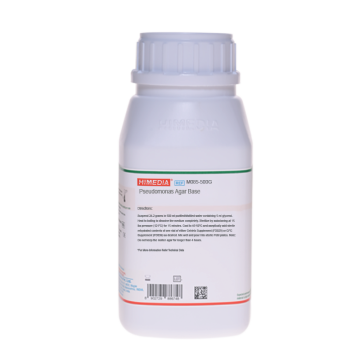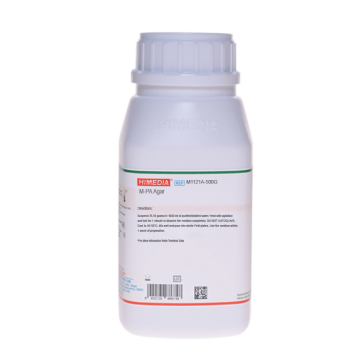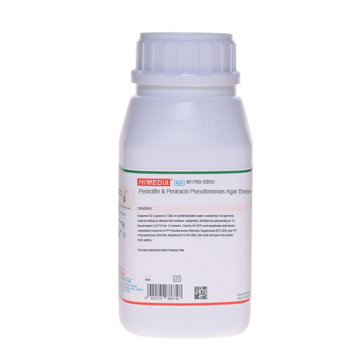 Your enquiry has been submitted
Your enquiry has been submitted
M-PA Agar Base
Intended Use
Recommended for detection and isolation of Pseudomonas aeruginosa by membrane filtration technique.
Composition**
| Ingredients | g/L |
|---|---|
| L-Lysine hydrochloride | 5.000 |
| Sodium chloride | 5.000 |
| Yeast extract | 2.000 |
| Xylose | 2.500 |
| Sucrose | 1.250 |
| Lactose | 1.250 |
| Ferric ammonium citrate | 0.800 |
| Sodium thiosulphate | 6.800 |
| Phenol red | 0.080 |
| Agar | 15.000 |
Final pH (at 25°C): 7.1±0.2
**Formula adjusted, standardized to suit performance parameters
Directions
Suspend 39.68 grams in 1000 ml purified/distilled water. Heat to boiling to dissolve the medium completely. Sterilize by autoclaving at 15 lbs pressure (121°C) for 15 minutes. Cool to 45-50°C and aseptically add rehydrated contents of 1 vial of M-PA Selective Supplement (FD202). Mix well and pour into sterile Petri plates or as desired.
Principle And Interpretation
The MPN (Most Probable Number) technique results in satisfactory recovery levels of Pseudomonas aeruginosa, but is not usable for the testing of large-volumes water samples and they also lack precision for the recovery of Pseudomonas aeruginosa.
Levin and Cabelli devised M-PA Agar as a selective membrane filter medium for Pseudomonas aeruginosa (1). Many of the filter media used for the recovery of P. aeruginosa lack specificity and are of limited value when a large heterogeneous microbial flora is present in the water samples. The original medium was modified by raising the pH (2) and altering the content or concentration of ingredients (3). This media is included in part 914 C, Membrane Filter Technique for P.aeruginosa (Tentative) in the 23rd Edition of Standard Methods for the Examination of Water and Waste water (4). Yeast extract, lysine and carbohydrates provide nitrogeneous compounds, energy sources and vitamins required for bacterial metabolism. Sodium chloride maintains osmotic equilibrium. Inorganic salts provide essential ions. Kanamycin inhibits protein synthesis in gram-positive organisms (5). Cycloheximide (FD202) inhibits fungal flora. Nalidixic acid blocks replication of susceptible gram-negative bacteria (5). Phenol red is the pH indicator which turns yellow under acidic conditions due to fermentation of the carbohydrates.
Type of specimen
Water samples: Chlorinated potable water, Swimming pool, Thermal springs, Salt water.
Specimen Collection and Handling:
After filtration of the water sample through a sterile 0.45 µm gridded filter, place the membrane filter on the surface of plates of M-PA Agar Base taking care to avoid the entrapment of bubbles between the agar and filter surface. Incubate for 24 hours at 41.5±0.5°C in an aerobic atmosphere. Optimal colony density on membrane filters is 20-200 colonies. All colonies on the filter are counted when the density is 2 or fewer per square; the average of 10 squares is determined when the count is 3-10 colonies per square and the average of 5 squares is determined when the count is 10-20 colonies per square. The average count per square is multiplied by 100 times the reciprocal of the dilution to give colonies per ml. After use, contaminated materials must be sterilized by autoclaving before discarding.
Warning and Precautions
Read the label before opening the container. Wear protective gloves/protective clothing/eye protection/face protection. Follow good microbiological lab practices while handling specimens and culture. Standard precautions as per established guidelines should be followed while handling specimens. Safety guidelines may be referred in individual safety data sheets.
Limitations
- Individual organisms differ in their growth requirement and may show variable growth patterns on the medium.
- Each lot of the medium has been tested for the organisms specified on the COA. It is recommended to users to validate the medium for any specific microorganism other than mentioned in the COA based on the user's unique requirement.
- Further biochemical and serological test are necessary for confirmation.
Performance and Evaluation
Performance of the medium is expected when used as per the direction on the label within the expiry period when stored at recommended temperature.
Quality Control
Appearance Light yellow to pink homogeneous free flowing powder
Gelling Firm, comparable with 1.5% Agar gel
Colour and Clarity of prepared medium Orange red coloured clear to slightly opalescent gel forms in Petri plates
Reaction Reaction of 3.97% w/v aqueous solution at 25°C. pH: 7.1±0.2
pH 6.90-7.30
Cultural Response Cultural characteristics observed after an incubation at 41.5 ± 0.5°C for upto 72 hours with added M-PA Selective Supplement (FD202)
| Organism | Inoculum (CFU) | Growth | Colour of medium |
|---|---|---|---|
| Escherichia coli ATCC 25922 (00013*) | >=104 | inhibited | |
| Klebsiella pneumoniae ATCC 13883 (00097*) | >=104 | inhibited | |
| Pseudomonas aeruginosa ATCC 27853 (00025*) | 50-100 | good-luxuriant | pink |
| Salmonella Typhi ATCC 6539 | >=104 | inhibited | |
| Staphylococcus aureus subsp. aureus ATCC 25923 (00034*) | >=104 | inhibited |
Key: (*) Corresponding WDCM numbers.
Storage and Shelf Life
Store between 10-30°C in a tightly closed container and the prepared medium at 2-8°C. Use before expiry date on the label. On opening, product should be properly stored dry, after tightly capping the bottle in order to prevent lump formation due to the hygroscopic nature of the product. Improper storage of the product may lead to lump formation. Store in dry ventilated area protected from extremes of temperature and sources of ignition. Seal the container tightly after use. Product performance is best if used within stated expiry period.
Disposal
User must ensure safe disposal by autoclaving and/or incineration of used or unusable preparations of this product. Follow established laboratory procedures in disposing of infectious materials and material that comes into contact with sample must be decontaminated and disposed of in accordance with current laboratory techniques (6,7).
Reference
- Levin M. A. and Cabelli V. J., 1972, Appl. Microbiol., 24:864.
- Carson L. A., Peterson M, J., Favero M. S., Doto I. L., Collins D. E. and Levin M. A., 1975, Appl. Microbiol., 30:935.
- Dutka B. J. and Kwan K. K., 1977, Appl. Environ. Microbiol., 33:240.
- Lipps WC, Braun-Howland EB, Baxter TE,eds. Standard methods for the Examination of Water and Wastewater, 24th ed. Washington DC:APHA Press; 2023.
- Estevez R. A., 1984, Bacteriologic plate media: review of mechanisms of action. Lab. Med. 15:258.
- Isenberg, H.D. Clinical Microbiology Procedures Handbook 2nd Edition.
- Jorgensen, J.H., Pfaller, M.A., Carroll, K.C., Funke, G., Landry, M.L., Richter, S.S and Warnock., D.W. (2015) Manual of Clinical Microbiology, 11th Edition. Vol. 1.
| Product Name | M-PA Agar Base |
|---|---|
| SKU | M1121 |
| Product Type | Regular |
| Physical Form | Powder |
| Origin | Animal |
| Packaging type | HDPE |
| References | 1.Levin M. A. and Cabelli V. J., 1972, Appl. Microbiol., 24:864.2.Carson L. A., Peterson M, J., Favero M. S., Doto I. L., Collins D. E. and Levin M. A., 1975, Appl. Microbiol., 30:935.3.Dutka B. J. and Kwan K. K., 1977, Appl. Environ. Microbiol., 33:240.4.Greenberg A. E. , Trussell R. R. and Clesceri L. S., (Eds.), 1985, Standard Methods for the Examination of Water andWastewater, 16th / 19th Ed., APHA, Washington, DC.5.Estevez R. A., 1984, Bacteriologic plate media: review of mechanisms of action. Lab. Med. 15:258. |
| Customized Product Available | No |









